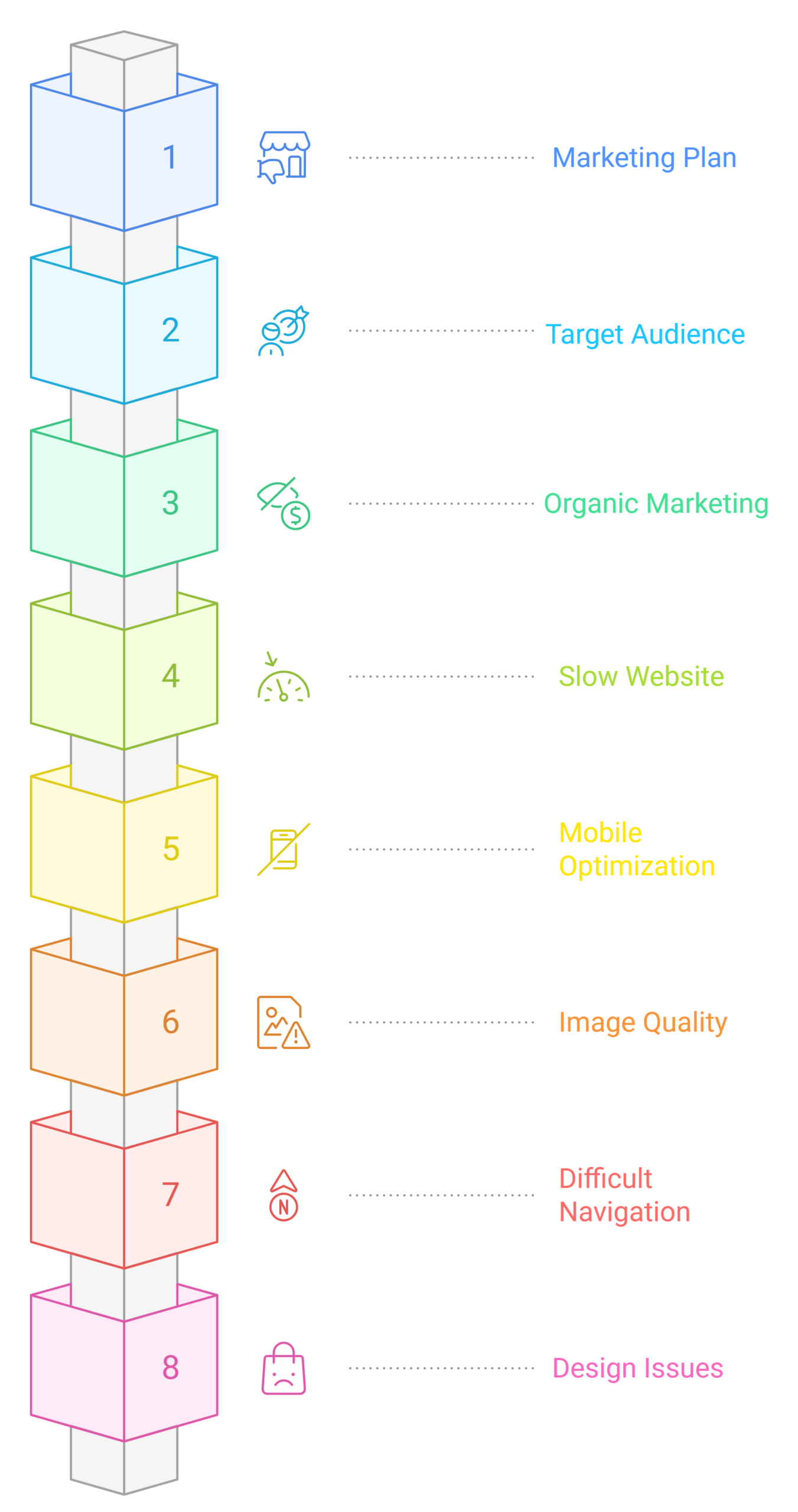“Why isn’t my Shopify store getting sales?” If you’ve asked yourself this question, you’re not alone. Shopify makes it super easy to set up an online store, but success doesn’t just come from clicking “publish.” Many new store owners jump in excitedly but end up making common mistakes that slow down their growth or, worse, prevent them from making sales at all.
The good news? You don’t have to repeat the same errors.
In this blog, we’ll go through 10 common mistakes new Shopify store owners make and how to avoid them, so you can save time, money, and stress.
Let’s get started.
Common Shopify Store Mistakes & How to Avoid Them

- Not Having a Solid Marketing Plan
Building your Shopify store is only half the journey; the other half is bringing in traffic. Many beginners make the mistake of launching without a clear marketing plan. They expect customers to appear magically. Spoiler alert: they won’t. You don’t need to master everything at once, but you do need a roadmap. Think of marketing as the fuel that keeps your store running.Fix:
- Email marketing (build a list and nurture leads).
- Social media posts (Instagram, TikTok, or Pinterest, depending on your niche).
- Content marketing (blogs, guides, or videos to answer your audience’s questions).
- Not Knowing Your Target Audience
“If you try to sell to everyone, you end up selling to no one.”
Many store owners make the mistake of going broad, assuming their product will appeal to anyone. The reality is, online shoppers are picky, and they want brands that feel like they “get” them. When you tailor your product descriptions, ads, and designs to a specific group, you’ll connect deeper and convert faster.
Fix:- Who is most likely to buy my product?
- What are their pain points, needs, or desires?
- What kind of language do they use?
- Not Investing in Organic Marketing
Paid ads can bring quick traffic, but relying only on them is a dangerous (and expensive) strategy. The moment you stop paying, your sales can dry up. Think of organic marketing as planting seeds; you may not see results overnight, but they’ll grow into a steady flow of customers.Fix:- Search Engine Optimization (SEO): Optimize product titles, meta descriptions, and blogs to appear on Google.
- Blogging: Write about topics your customers search for, like “How to choose the right yoga mat,” if you sell fitness gear.
- Social media content: Use reels, pins, or stories to grow awareness naturally.
- Having a Slow Website
Nothing kills a sale faster than a slow website. Online shoppers are impatient if your store takes more than 3 seconds to load; many will click away. Speed = sales. A fast store keeps customers engaged and builds trust.
Fix:- Choose a lightweight, fast-loading theme.
- Compress large images before uploading.
- Remove unused apps that slow your site down.
- Use Shopify’s built-in speed reports to monitor performance.
- Ignoring Mobile Optimization
Here’s a fact: most online shopping happens on smartphones.
Yet, many Shopify store owners design their websites while looking at a desktop screen and forget to test the mobile experience. A smooth mobile shopping experience isn’t optional anymore; it’s mandatory.
Fix:- Choose a mobile-friendly Shopify theme.
- Test your store on different devices (phones, tablets, etc.).
- Make buttons, images, and text easy to tap and read.
- Poor Image Quality
Would you buy from a store that uses blurry, pixelated, or generic stock photos? Probably not. High-quality visuals are one of the biggest trust builders in e-commerce. Good photos tell a story and make your products feel real. They don’t just show the item; they sell the experience.Fix:- Use high-resolution images that are clear and bright.
- Show products from multiple angles.
- Include lifestyle shots (show the product in use, not just against a white background).
- Difficult Navigation
Imagine walking into a physical store where products are scattered everywhere and there are no signs. You’d leave, right? The same happens online. If customers can’t find what they’re looking for quickly, they’ll exit your store. The goal? A visitor should be able to find any product in 3 clicks or fewer.
Fix:- Keep your menu simple.
- Use clear categories and subcategories.
- Add a search bar to make browsing easier.
- Shopify Design Issues
Your store design is like your brand’s first impression. A cluttered, messy, or outdated design can make your business look unprofessional. Remember, less is more. A clean, easy-to-read design builds credibility and keeps visitors focused on your products, not distractions.Fix:- Choose a clean, modern theme.
- Stick to 2-3 brand colors and 1-2 fonts.
- Leave plenty of white space (don’t cram everything together).
- Weak Product Descriptions
A common mistake is copying manufacturer descriptions or writing vague one-liners like “High-quality shoes, available in different sizes.” That doesn’t sell. For example, instead of “Cotton T-shirt,” say: “Made with 100% organic cotton, this T-shirt feels soft on your skin, keeps you cool in the summer, and lasts wash after wash.”
Fix:- Write product descriptions that highlight benefits, not just features.
- Use short, scannable sentences.
- Answer common customer questions (size, fit, material, warranty, etc.).
- Complicated Payment Process
You worked hard to get someone to the checkout page, but if the process is long or confusing, they’ll abandon their cart. A smooth, fast checkout makes buying effortless and helps you recover more sales.
Fix:- Offer guest checkout (don’t force account creation).
- Keep the process short (fewer steps = fewer drop-offs).
- Provide multiple payment options (credit card, PayPal, Shop Pay, Apple Pay, etc.).
Wrapping Up
Launching a Shopify store is an exciting journey, but success doesn’t come from simply setting it live; it comes from learning, adapting, and improving along the way. Many beginners stumble because of avoidable mistakes, such as unclear marketing, weak product pages, or a complicated checkout process.
But here’s the good news: once you know what to look out for, these challenges are easy to fix. By focusing on your audience, building trust through design and descriptions, and creating a smooth shopping experience from start to finish, you set your store apart from the crowd.
Remember, every successful store owner started where you are right now. The difference is, they kept learning, tweaking, and moving forward.
If you avoid these common mistakes and stay committed to improving, your Shopify store won’t just survive; it will thrive, grow, and become the business you always dreamed of.

With a Bachelor’s in Commerce and 15 years of experience in Ecommerce SEO and Shopify Development, I bring extensive expertise to the digital field. As Managing Partner at WillShall Consulting, I lead a team delivering exceptional Digital Marketing, Web Development, and Web Designing services. My passion for innovation and commitment to excellence help businesses thrive in the digital age.





 Call Us
Call Us Email Us
Email Us Video Call
Video Call




